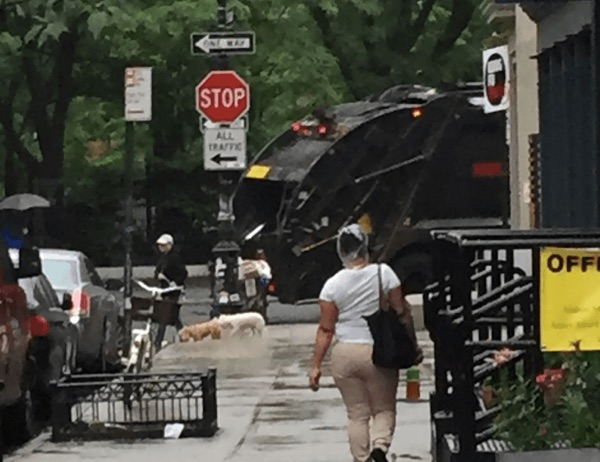ProPublica is out today with an exposé of New York's commercial waste carting companies, whose drivers killed seven people on city streets last year. It's a must-read investigation into an industry where hazardous and exploitative labor conditions have left a long trail of injuries and deaths.
Labor, environmental, and street safety advocates have teamed up to campaign for reforms to the industry. ProPublica reporter Kiera Feldman shows in compelling and terrifying detail why the commercial trash hauling system is so broken.
Commercial waste is the responsibility of private sanitation companies -- as opposed to municipal and residential waste, which is handled by the Department of Sanitation. Those companies contract their services to clients that tend to be spread out across the city, forcing workers on long, exhausting routes. In 2016, the city announced plans to shift to a "zone-based" collection system, where each company would serve defined geographic areas, cutting down on truck mileage and, presumably, driver fatigue. But the industry has so far been resistant.
The ProPublica piece, which Feldman spent over a year investigating, describes workers forced to endure long overnight shifts, faulty equipment, repeated physical injury, overbearing supervisors with no regard for traffic laws, and low wages. Given those conditions, it's not surprising that private trash carters have killed at least 13 people in NYC since 2012, according to data compiled by Streetsblog.
In the 1990's, prosecutors broke up the Mafia-run cartels that had controlled the private carting industry for generations. As the mob's grip receded, so did the workers' union representation. "Independent unions" replaced the Teamsters and signed binding contracts with the companies that significantly reduced worker wages and protections.
City sanitation workers, in contrast, work eight-hour days along zone-based routes, have a median base salary of $69,000 plus healthcare and a pension, and a union that actually represents their interests. (DSNY workers have not been involved in a traffic fatality since 2014.)
For the story, Feldman rode along with a driver, Alex Caban, and you get a sense of how brutal the industry has become for workers. Caban took Feldman on a 10-hour run that went from a truck lot in Crown Heights, east into Brooklyn, and eventually into Manhattan -- as far north as Washington Heights. After three years in the industry, Caban was "marked head-to-toe" with physical injuries suffered on the job, according to Feldman, including a gash in his skull and a severed finger. (You can trace one night of work for Caban on this interactive map.)
The employers don't seem to see a connection between their labor practices and the threat their industry poses to public safety. In one telling passage, industry officials attending a safety forum this past October blamed crash victims for their own deaths:
In October, garbage company owners, lobbyists and city officials held an event billed as a Safety Symposium, where industry participants seemed more eager to blame cyclists than take responsibility. “We’ve been talking about as an industry what we’ve been doing,” said Bill Falletta, safety manager of Action Carting, whose truck killed 27-year-old cyclist Neftaly Ramirez in the Greenpoint neighborhood of Brooklyn on July 22. “Is there anything being done to educate the bicyclists on safety? They should be following the same traffic rules that we do. I very rarely see that.” Later, when a city official explained that — although it was perhaps counterintuitive — narrower streets are actually safer because they slow the flow of traffic, David Biderman, an industry lobbyist, raised his hand and asked if narrower bike lanes could be used to slow down bicyclists. The consensus seemed to be that two-wheeled transportation was the real menace on the road.
The de Blasio administration has laid out a two-year timetable to develop a comprehensive reform package for the industry, including the transition to zone-based routes. Implementation would presumably take more time after the plan is finalized.
Advocates say the city is sticking to its schedule. Given the life-and-death implications, reforms can't come soon enough.






